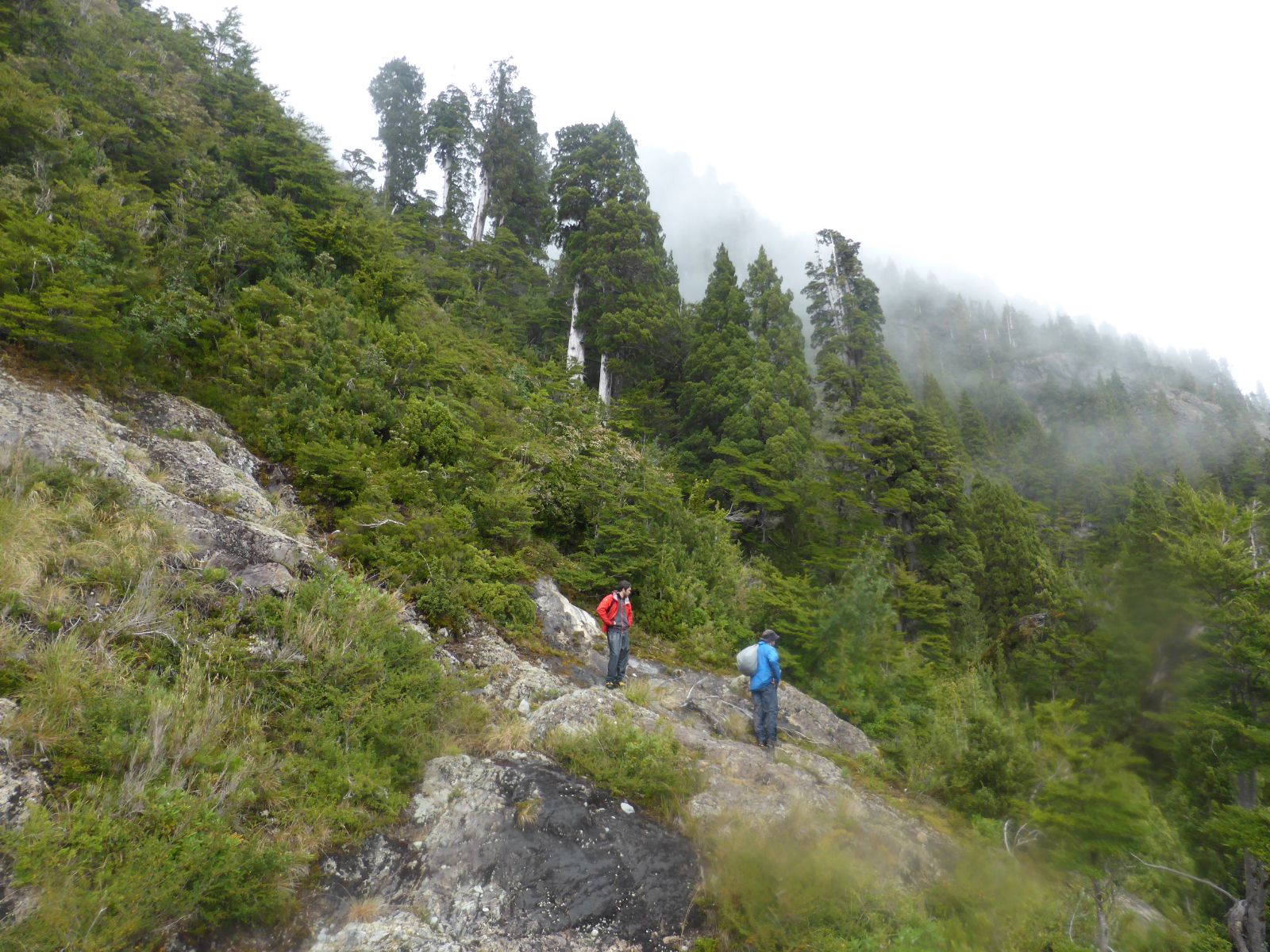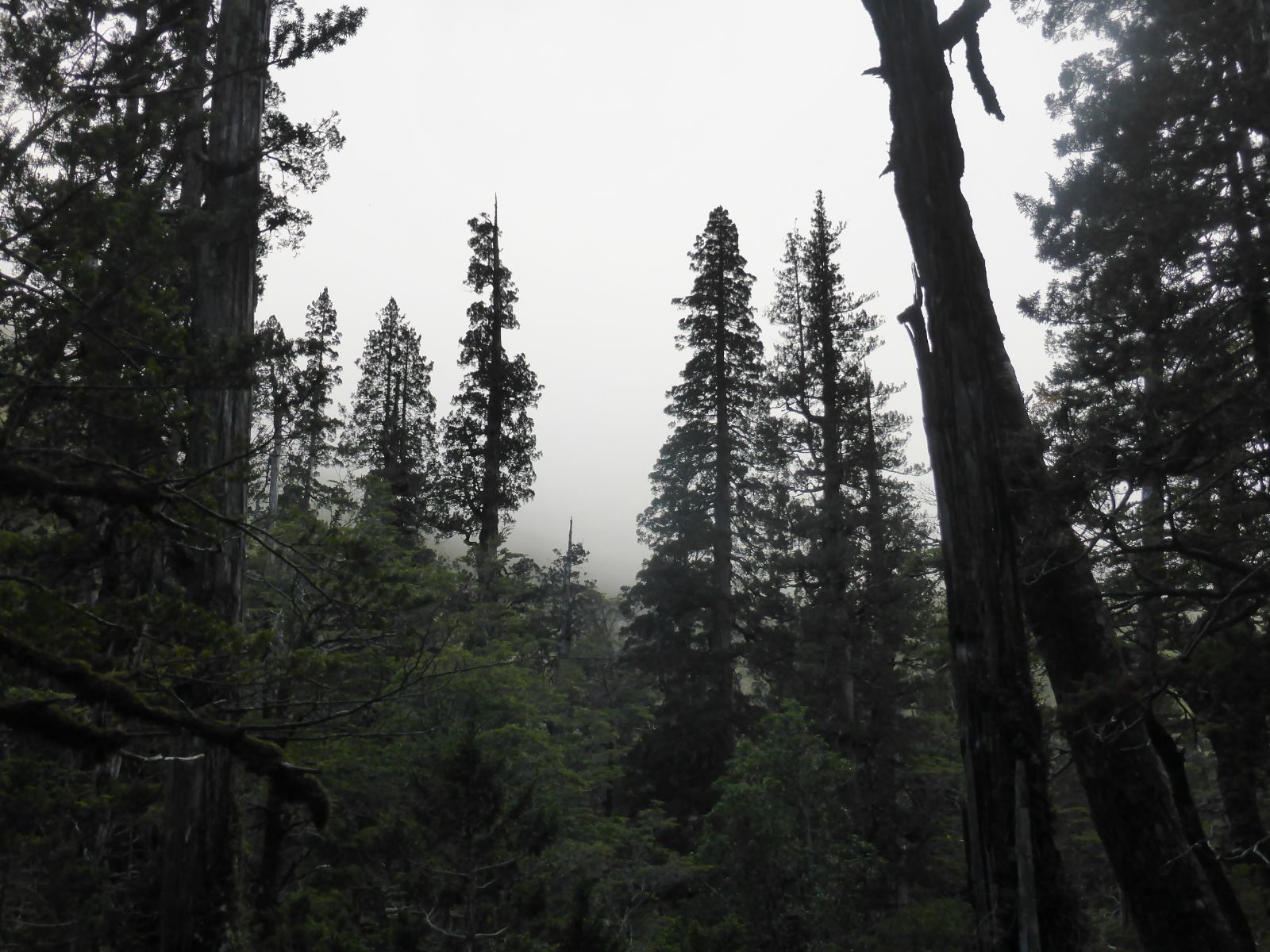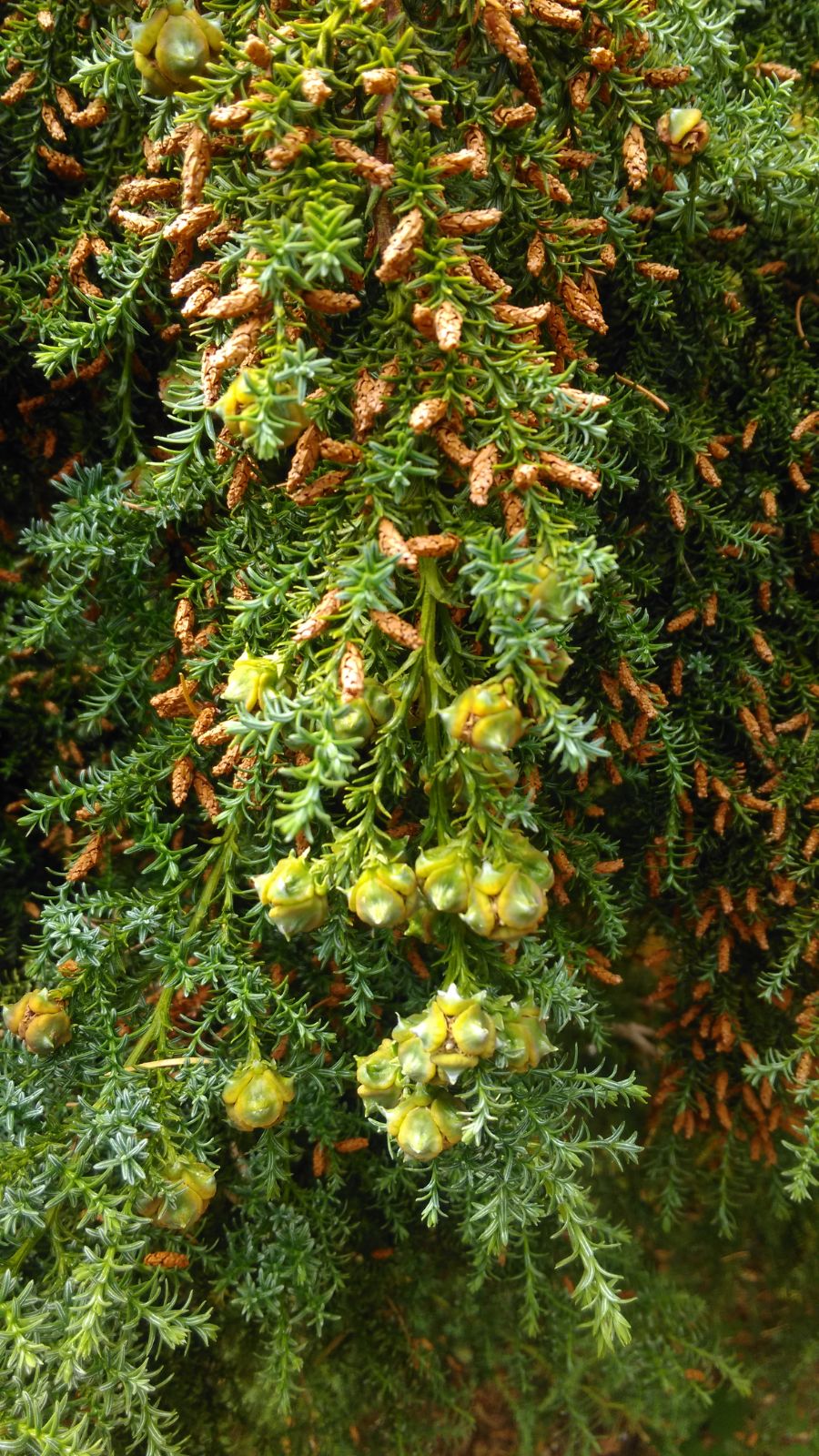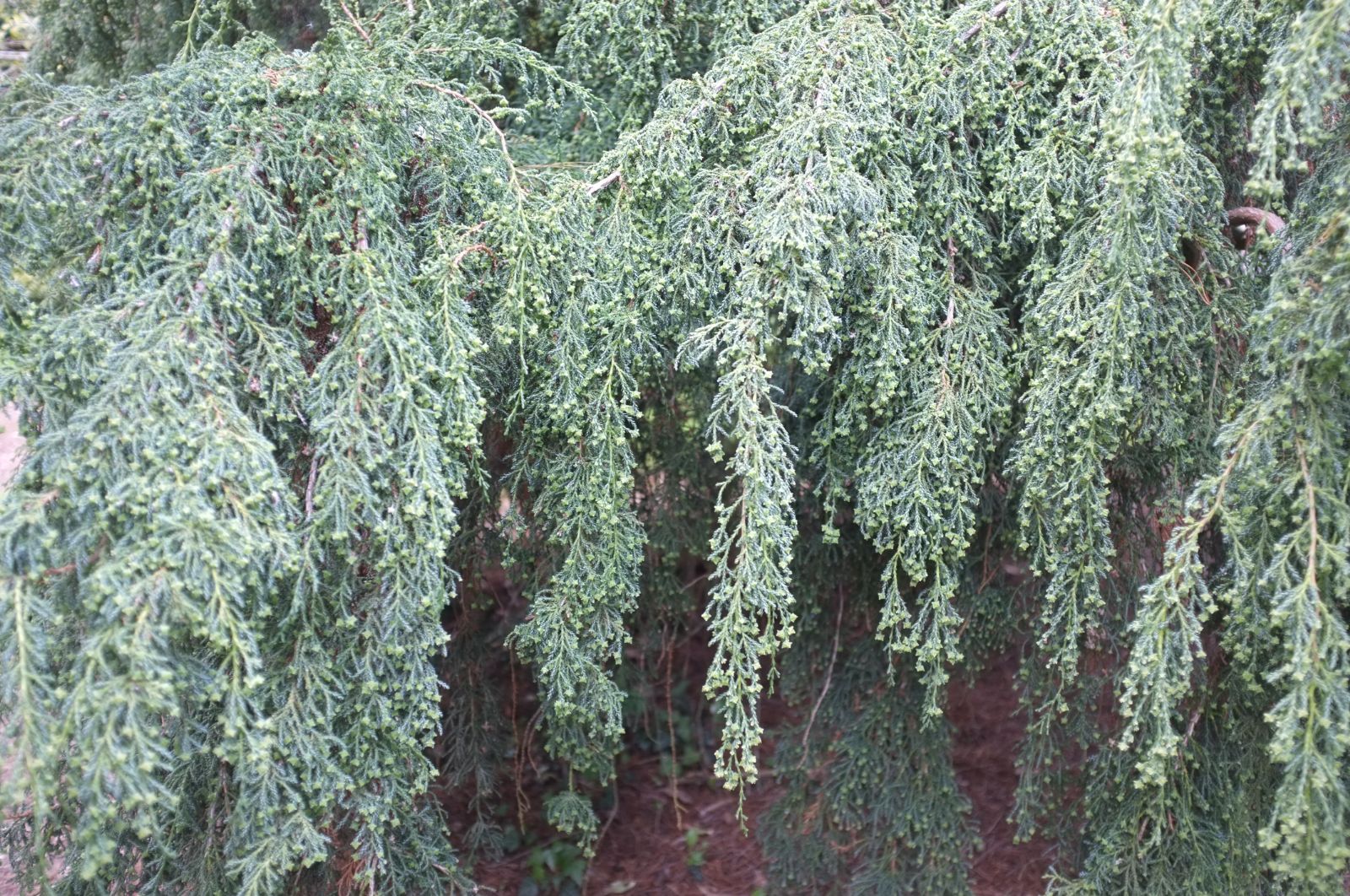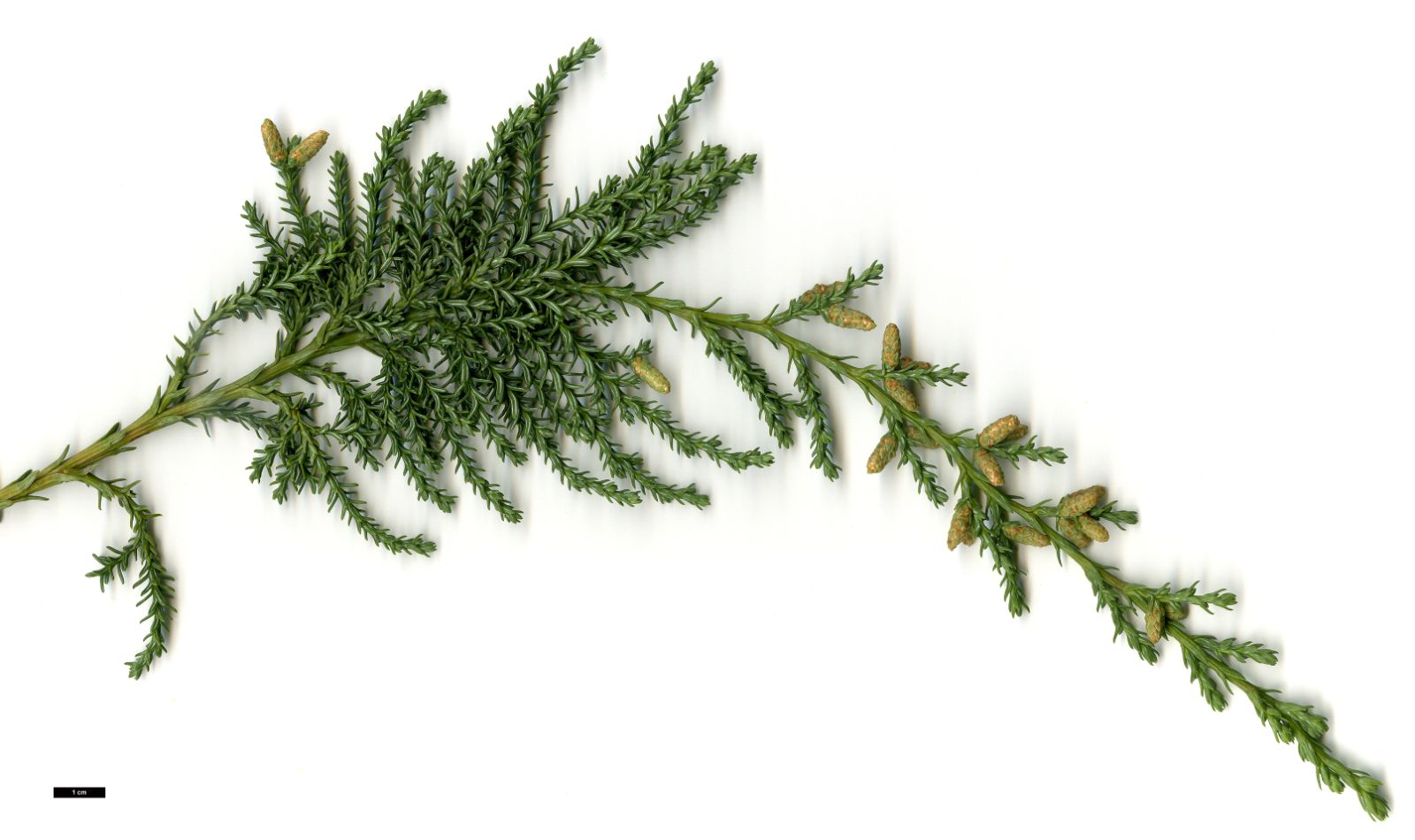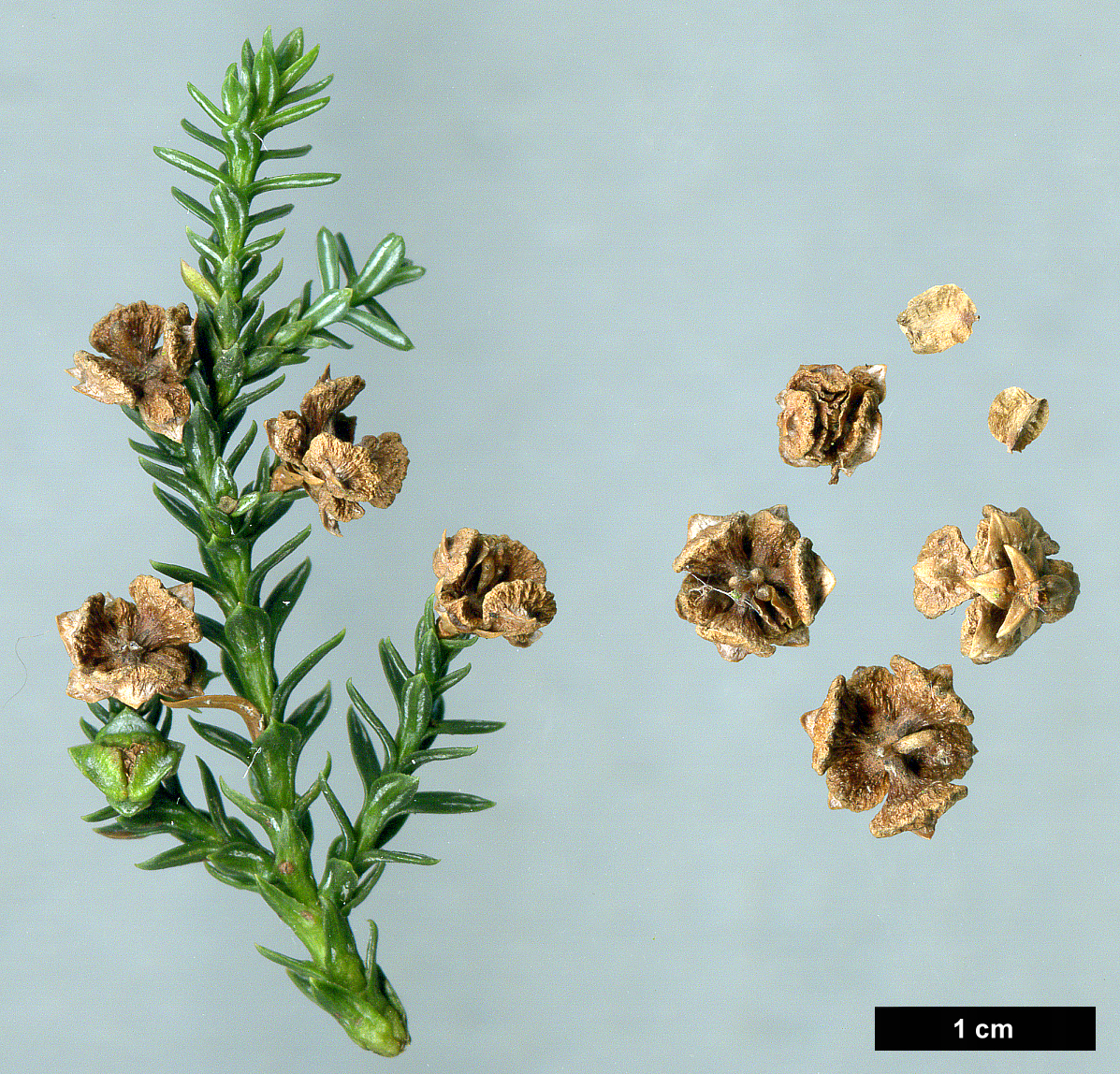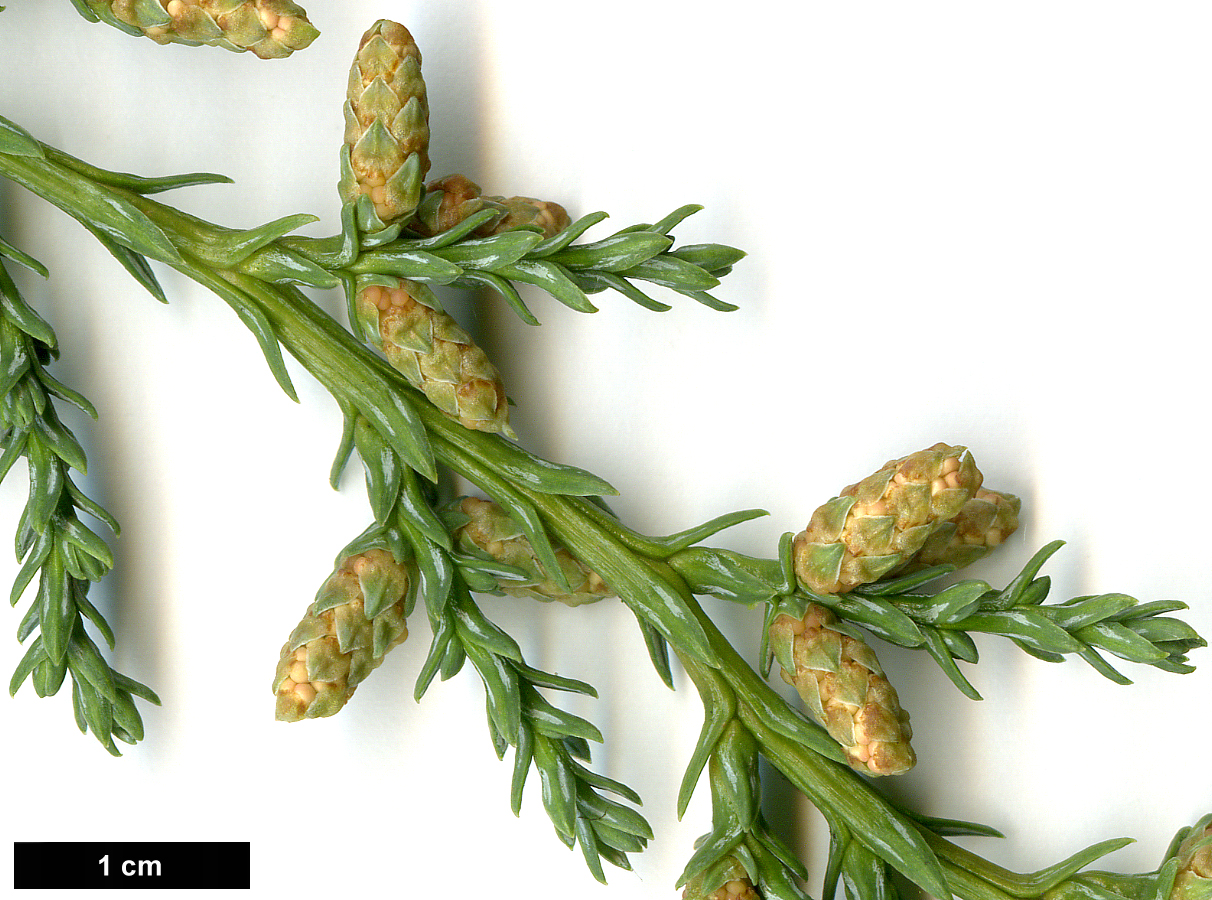Fitzroya cupressoides
Sponsor
Kindly sponsored by
The Samuel Storey Family Charitable Trust
Credits
Tom Christian (2018)
Recommended citation
Christian, T. (2018), 'Fitzroya cupressoides' from the website Trees and Shrubs Online (treesandshrubsonline.
Other taxa in genus
Trees 40–60(–70?) m × 3– 5 m dbh in the wild, with a narrowly pyramidal or conical crown, usually strongly monopodial when young but often with multiple leaders in old age. Sometimes a relatively stunted shrub at high elevations or on particularly poor ground. Bark reddish-brown, furrowed and fibrous, shedding intermittently in upwardly curving longitudinal strips, which bleach to a pale grey. Branchlets glabrous, maturing from yellow-green to reddish-brown and then grey-brown. Leaves scale-like, arranged in whorls of three, dark or mid-green or slightly glaucous, with stomatal banding on both leaf surfaces, in two prominent silvery-white bands on the dorsal side, in dots on the ventral side. On older branches leaves ovate, often imbricate, 2.5–3 mm long, keeled, decurrent at base with acute or rounded tips; on young branches leaves spathulate, 5–8 mm long, flattened and often set well apart. Usually dioecious, occasionally monoecious: pollen cones solitary, borne terminally on axillary branches, 6–8 mm long, a bright pale yellow, maturing yellow-brown; seed cones globose, 0.6–1 cm across, of six to nine woody scales in alternating whorls of three with prominent umbos, yellow-green maturing brown, borne terminally on short lateral shoots, often very densely so toward the branch tips. Seeds 2–3 mm across with two or three wings set around the seed. (Debreczy & Rácz 2011; Premoli & Gardner 2015).
Both in cultivation and in the wild it is possible to confuse F. cupressoides with Pilgerodendron uviferum. The foliage of Pilgerodendron is regularly arranged in decussate pairs, giving shoots a distinctly quadrangular appearance, while Fitzroya’s foliage is arranged in alternating whorls of three. In cultivation, Chamaecyparis pisifera cultivars, which retain their juvenile foliage, have occasionally been mistaken for Fitzroya, but the prominent aroma of juniper berries from the crushed foliage of C. pisifera quickly distinguishes this species.
Distribution Argentina Chubut, Neuquén, and Río Negro provinces, in the Andes. Chile Los Lagos, in the Coastal Cordillera, the Central Valley, the Andes, and on the island of Chiloé.
Habitat Typically on poorly drained and often nutrient-poor soils derived from volcanic ash, sandy, humus-rich and acidic at low and medium elevations. Over a relatively large altitudinal range in Chile it occurs in a range of forest types, and with a broad range of associated species typical of the Valdivian rainforest.
USDA Hardiness Zone 7a-9a
RHS Hardiness Rating H6
Conservation status Endangered (EN)
Early on in every dendrologist’s education there is a moment of incredulity when we learn just how enormous trees can become, and then another when we learn just how long they can live. The keen observer becomes more intrigued still when we notice that so many of these mammoth trees are conifers. Our first introduction to this group of giants is usually California’s Sequoiadendron giganteum, with Sequoia sempervirens hot on its heels. Later, we come to realise that there are comparable conifers scattered all over the world: Cryptomeria japonica in the far east, Taiwania cryptomerioides in southeast Asia, Agathis australis in New Zealand, Cupressus cashmeriana in the eastern Himalaya, all capable of great size and often great age.
The South American representative of this elite group of giant and long-lived conifers is Fitzroya cupressoides, endemic to a relatively small area of southern Chile, from Valdivia south to Chiloé over an altitudinal range from 100 to c. 1,500 m asl, and in adjacent areas of the Argentinean Andes at altitude (Premoli & Gardner 2015). The tallest officially recorded is a 57 m tall tree with a dbh of 2.2 m growing in Argentina’s Los Alerces National Park, although trees in excess of 60 m height are thought to exist (Earle 2018). A tree with a dbh of 4.26 m may be found in Chile’s Parque Nacional Alerce Costero (Debreczy & Rácz 2011). The oldest recorded example was 3,613 years old, making Fitzroya the second longest-lived tree after Pinus longaeva (Gardner, Hechenleitner & Hepp 2015).
It was from Chile that William Lobb introduced the species to cultivation in the British Isles in 1849, when he was working for the Veitch nurseries, who also employed Richard Pearce who is thought to have made further collections ten years later (Gardner et al. 1999). It has been in cultivation since this time although it remains scarce and generally confined to specialist collections.
It is certainly very rare in cultivation elsewhere. It may be found in North American collections, having been introduced to the continent in or before 1871 (Jacobson 1996), for example at the University of California Berkeley Botanic Garden (University of California Botanical Gardens at Berkeley 2018), and at the Washington Park Arboretum (University of Washington Botanic Gardens 2018). It is also grown on the east coast, for example at the Arnold Arboretum, where it is represented by several accessions, some of known wild origin (Arnold Arboretum 2018). It is present in continental European collections, for example at Arboretum Wespelaar in Belgium (Arboretum Wespelaar 2018) and there is a record of its introduction to the Faroe Islands from the Danish Scientific Expedition to Patagonia in 1975, where it survived until at least 1986 (Ødum, Hansen & Rasmussen 1989). Other material from this expedition was distributed to collections in Denmark, southwest Sweden and western Norway (Madsen, Nielsen & Ødum 1980) but it isn’t clear if these collections survive to the present day. It is cultivated in New Zealand (Eastwoodhill Arboretum 2018) and in Tasmania (The Tasmanian Arboretum 2018) and in mainland Australia at Mount Lofty Botanic Gardens (The Botanic Gardens of South Australia 2018).
Although in its wild state it can attain great size, in cultivation it has so far made only medium-sized trees of 10–21 m height with a dbh of up to 0.94 m. It is most commonly multi-stemmed from a young age, especially when propagated by cuttings, but some seed-raised plants are forming single-stemmed trees. Older trees in cultivation have irregular crowns and congested branching. Although growth can be rapid in its early years (see below) older trees grow very slowly. The 21 m specimen grows at Ardkinglas Woodland Garden in Argyll, Scotland, and has the following historic measurements: 17.7 m (58 ft) in 1969; 20.7 m (68 ft) in 1982; 21 m (69 ft) in 2015. That it has barely grown in over 35 years does beg the question ‘has it lost its top?’ but David Gray, horticulturist at Benmore Botanic Garden and formerly at Ardkinglas, suggests that on the west coast of Scotland, Cupressaceae reach an optimum height, subject to the local environment, and then bulk out in girth and canopy width (D. Gray pers. comm. 2018).
Other sizeable cultivated trees are generally distributed in the west of Scotland, the south and southwest of England and across the island of Ireland. Examples may be found at: Benmore Botanic Garden, Argyll (accession 19588381*C; 19 m tall in 2017), at Tregrehan, Cornwall (17 m in 2014) and at Mount Usher, County Wicklow (15 m in 2015). There are also several good examples in southeast of England, for example at High Beeches, West Sussex (14.8 m in 2018) (The Tree Register 2018). In the wild, the species experiences average annual precipitation of between 2 and 4 m per year (Premoli & Gardner 2015) hence it is particularly suited to cultivation in oceanic climates like that of the UK and Ireland, with plentiful precipitation and no extremes of temperature, although young trees have survived extremes of both heat and cold, for example 36°C at the University of Oxford’s Harcourt Arboretum (B. Jones pers. comm. 2018) and –18°C at Cluny House Gardens, Perthshire, during the winter of 2009–2010 (J. Mattingley pers. comm. 2018).
A fascinating piece of research in the late 1990s, led by the Royal Botanic Garden Edinburgh’s International Conifer Conservation Programme (ICCP) in collaboration with the University of Edinburgh, revealed that the majority of older trees of Fitzroya in the UK and Ireland were clonal (Allnult et al. 1998). This strongly suggests that early attempts to establish the species in cultivation were largely unsuccessful and that in the end only a single plant persisted, and that this plant was vegetatively propagated and distributed to a limited number of collections, which very likely rooted further cuttings and passed these on in turn. Certainly, more recent experience from the ICCP has shown that achieving successful seed germination is very difficult, and cuttings, although relatively easy like much of the Cupressaceae, must be absolutely fresh when struck (pers. obs.).
This ‘classic’ clone in cultivation – derived from Lobb’s 1849 introduction (Gardner et al. 1999) – is female and has characteristic, markedly pendulous branchlets and relatively open foliage. It is still regularly propagated and occasionally seen for sale in specialist nurseries, although if inappropriate material is selected it can struggle to form a leader even with relentless staking, and has been known to grow around and around in circles inside its protective cage! When growing well it makes an attractive, medium-sized conifer of columnar habit – densely so when young – and can grow into a tree of great beauty.
It has been suggested that this historic clone should be given a cultivar name, not necessarily because it deserves one, but because doing so would aid future distinction as more recent introductions mature and become more widespread in cultivation, particularly via unsanctioned repropagation (pers. obs.). Certinaly, since the 1990s the ICCP has repeatedly introduced new collections to cultivation from its extensive programme of fieldwork in Chile. These introductions have included seed, but these have largely been unsuccessful with germination rates being extremely low, although a handful of exceptions do exist. Most successful introductions have been as cuttings, and as of November 2018 the ICCP monitors c. 324 individual plants of known direct or indirect wild origin growing in 88 sites across the UK, Ireland and Belgium, representing c. 90 different genotypes (BG-BASE, 2018). These new introductions exhibit interesting diversity in their morphology: some have very short, forward-pointing needles, which are densely imbricate, while others have longer needles, spreading almost perpendicular to the shoot and relatively sparsely set, there are also many of both male and female clones, and some young trees are exhibiting monoecy (pers. obs.).
One of the largest plantings resulting from these introductions is at Benmore Botanic Garden in Argyll, Scotland, where over 50 plants are growing in the Chilean rainforest glade that has been established since 1998, with new plantings being added regularly to achieve diversity in age structure. The largest here has achieved c. 6 m height since being planted in 1998. Elsewhere, the largest plant resulting from ICCP introductions is currently a tree at Knightshayes, Devon. It was planted in 2002 and by December 2017 had reached an impressive 7.5 m tall with a dbh of 9 cm. Various other trees have exceeded 5 m height in c. 15–20 years growth, including: Birr Castle, County Offaly, Ireland (planted 2000, 7.3 m in 2018); Ardkinglas Woodland Garden, Argyll (planted 2000, 5 m in 2016); Longdown Estate, Hampshire (planted 2002, 5 m tall and 5.5 cm dbh in 2014); Sir Harold Hillier Gardens, Hampshire (planted 2002, 5 m in 2015); the Eden Project, Cornwall (planted 2002, 5.5 m in 2018); Picton Castle, Pembrokeshire (planted 2002, 5.7 m tall and 11 cm dbh in 2018); Fota Arboretum, County Cork, Ireland (planted 2000, 5.5 m tall and 7.5 cm dbh in 2015); and Grey Abbey, County Down (planted c. 2004, 5.5 m tall and 12 cm dbh in 2017) (BG-BASE, 2018).
These and over 300 other individuals planted throughout the UK and Ireland, from the south coast as far north as Ullapool, form a significant ex-situ conservation collection of a species which is classified as endangered in the wild. Fitzroya has a fascinating cultural history, and the extraordinary human interaction with – and the sad demise of – the once great Alerce forests of southern Chile is extensively and authoritatively covered elsewhere, for example by Gardner et al. (1999).
Suffice to say that successive European settlers in Chile made extensive use of Fitzroya’s strong and extraordinarily durable timber from the 16th century onward – they also burnt gigantic areas of forest to clear ground for agriculture. By the mid-20th century exploitation of its timber and conversion of its lands had caused an almost unfathomable loss of Fitzroya forest, such that in 1973 it was listed on CITES in an attempt to arrest the international trade in its timber, and in 1976 the Chilean authorities declared all remaining stands a national monument, prohibiting the cutting of any living trees. Illegal exploitation continues to this day, though, and habitat degradation through grazing and fire continues to threaten the species, as does poor levels of natural regeneration (Premoli & Gardner 2015).


